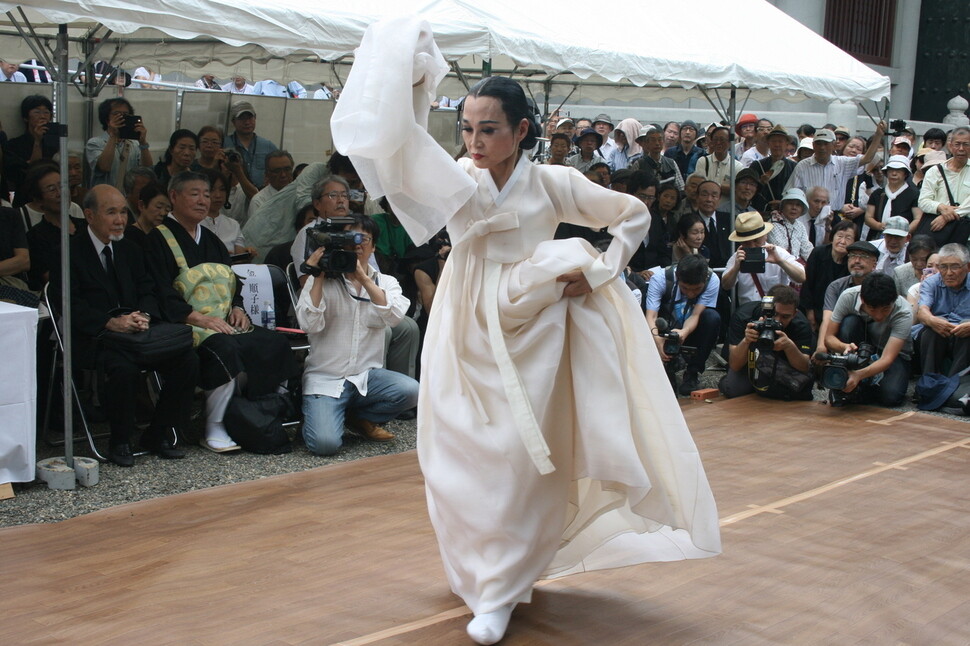hankyoreh
Links to other country sites 다른 나라 사이트 링크
[Reportage] Memorial service held for Korean victims slaughtered during Great Kanto earthquake

A 96th anniversary memorial ceremony for Korean victims of massacres following the Great Kanto earthquake took place on Sept. 1 at Yokoamicho Park in Tokyo’s Sumida Ward. As intangible cultural heritage possessor Kim Soon-ja was performing a dance in white mourning clothes to soothe the spirits of the Koreans slaughtered in the earthquake’s wake, Japanese right-wingers who deny the massacre happened could be heard nearby shouting into a microphone. On the pretext of “remembering Japanese victims,” right-wing forces have been holding events and chanting massacre denialist slogans for the past three years at a distance of just 30m from the Korean victims’ memorial ceremony venue. During the right-wing event, Nobuyuki Suzuki, a member of the Katsushika ward council, declared, “We cannot pass false history down on future generations. This must be stopped.” Suzuki is the person responsible for a 2012 incident in which a stake bearing the words “Takeshima is Japanese territory” was tied to a comfort women statue in front of the Japanese Embassy in Seoul.

It was three years ago that right-wingers began holding the obstruction event in front of the Korean massacre victim memorial ceremonies at Yokoamicho Park, which have been taking place since 1973. For the past three years since 2017, Tokyo Governor Yuriko Koike has refused to send the same condolence measures most of her predecessors had, arguing instead that “all earthquake victims should be commemorated together.” Koike has also made remarks that avoid acknowledging Japan’s responsibility for the massacre of Koreans, insisting that “many opinions exist” on the matter.

Right-wingers deny massacre, saying estimated 6,000 deaths is imprecise figure
Recently, right-wingers have been focusing their attacks on a message written on the memorial, which states that “six thousand Koreans had their sacrosanct lives taken from them.” In the wake of the Great Kanto earthquake on Sept. 1, 1923, false rumors that Koreans had “poisoned the wells” spread within Japan, and vigilante groups and soldiers massacred Koreans in Tokyo, Yokohama, Chiba, and elsewhere in the Kanto region. The Japanese government conducted no investigation at the time, attempting instead to cover up the carnage. The death toll of over 6,000 stated in the Independence Newspaper, which was the newspaper of the provisional government in Shanghai, is one of the few existing estimates, and it appears to be that number that is cited on the memorial at Yokoamicho Park. Claiming the estimate to be imprecise, right-wing forces have attempted to deny the massacre outright.
“The Japanese government has merely claimed that the matter is ‘under investigation’ – and 96 years have gone by,” said Kikuchi Enomoto, vice chairperson of the executive committee for the commemorative association for the Kameido incident, in which Japanese socialists were slain by vigilantes following the Great Kanto earthquake.
Yatsuhiko Miyakawa of the Tokyo federation of the Niccho Kyokai – the civic group that spearheaded the event – said at the memorial that he “strongly protest[s] Gov. Koike’s failure to send a statement of commemoration.”
“I hope she will listen to the many people demanding a statement and reconsider her decision,” he said.
The Niccho Kyokai collected signatures from 114 groups and 557 individuals this year to demand that Koike send a statement, but has received no response from the Tokyo governor.
“We must not allow the same mistake [with the Korean massacre] to be repeated. That is why we continue holding this event year after year,” Miyakawa said. Around 700 Japanese citizens lined up to leave flowers at the memorial.
For Disaster Prevention Day that day, the Japanese government conducted drills for a 7.3-magnitude “direct hit on the capital” earthquake scenario with an epicenter under Tokyo. The government placed major emphasis on the importance of disaster prevention, with Abe and numerous Cabinet officials taking part in the drill. But no mention of commemorating the Korean massacres was made by Tokyo.
By Cho Ki-weon, Tokyo correspondent
Please direct comments or questions to [english@hani.co.kr]

Editorial・opinion
![[Column] Life on our Trisolaris [Column] Life on our Trisolaris](https://flexible.img.hani.co.kr/flexible/normal/500/300/imgdb/original/2024/0505/4817148682278544.jpg) [Column] Life on our Trisolaris
[Column] Life on our Trisolaris![[Editorial] Penalties for airing allegations against Korea’s first lady endanger free press [Editorial] Penalties for airing allegations against Korea’s first lady endanger free press](https://flexible.img.hani.co.kr/flexible/normal/500/300/imgdb/original/2024/0502/1817146398095106.jpg) [Editorial] Penalties for airing allegations against Korea’s first lady endanger free press
[Editorial] Penalties for airing allegations against Korea’s first lady endanger free press- [Editorial] Yoon must halt procurement of SM-3 interceptor missiles
- [Guest essay] Maybe Korea’s rapid population decline is an opportunity, not a crisis
- [Column] Can Yoon steer diplomacy with Russia, China back on track?
- [Column] Season 2 of special prosecutor probe may be coming to Korea soon
- [Column] Park Geun-hye déjà vu in Yoon Suk-yeol
- [Editorial] New weight of N. Korea’s nuclear threats makes dialogue all the more urgent
- [Guest essay] The real reason Korea’s new right wants to dub Rhee a founding father
- [Column] ‘Choson’: Is it time we start referring to N. Korea in its own terms?
Most viewed articles
- 1New sex-ed guidelines forbid teaching about homosexuality
- 2OECD upgrades Korea’s growth forecast from 2.2% to 2.6%
- 360% of young Koreans see no need to have kids after marriage
- 4[Column] Life on our Trisolaris
- 5Months and months of overdue wages are pushing migrant workers in Korea into debt
- 6Korean government’s compromise plan for medical reform swiftly rejected by doctors
- 7[Guest essay] Maybe Korea’s rapid population decline is an opportunity, not a crisis
- 8S. Korea discusses participation in defense development with AUKUS alliance
- 9Presidential office warns of veto in response to opposition passing special counsel probe act
- 10Inside the law for a special counsel probe over a Korean Marine’s death